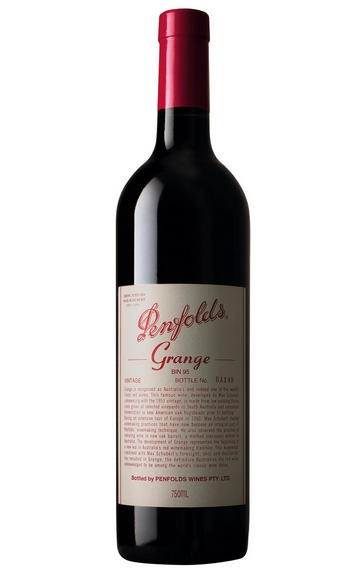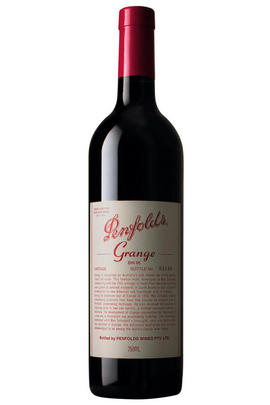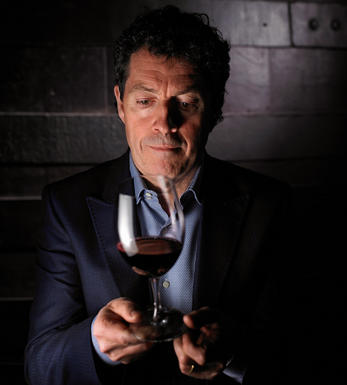
2007 Penfolds, Grange, Bin 95, Australia

Critics reviews
Very deep garnet-purple in color, the nose is intensely scented of vibrant blueberry preserve, mulberry and kirsch aromas over hints of cedar, mocha, vanilla and anise. The full bodied palate is richly fruited with pure black berry and baking spice flavors offset by crisp acidity and a firm level of velvety tannins, finishing long. This is quite an opulent, forward Grange, which is very tempting to drink now, though of course will reward at least 5-10 years of cellaring and should keep to 2030+.
(Lisa Perrotti-Brown, Wine Advocate - May 2012)
About this WINE

Penfolds
Penfolds enjoys an iconic status that few New World producers have achieved. Established in 1844 at the Magill Estate near Adelaide, it laid the foundation for fine wine production in Australia.
The winemaking team is led by the masterful Peter Gago; it has the herculean task of blending the best wines from a multitude of different plots, vineyards and regions to create a consistent and outstanding range of wines. Its flagship wine, Grange, is firmly established as one of the finest red wines in the world.
Under Gago’s stewardship, the Penfolds range has evolved over time. Winemaking has moved away from New World heat and the sort of larger-than-life style that can mask individuality; the contemporary wines instead favour fine balance and typicity for the region or grape.

Barossa Valley
Barossa Valley is the South Australia's wine industry's birthplace. Currently into its fifth generation, it dates back to 1839 when George Fife Angas’ South Australian Company purchased 28,000 acres at a £1 per acre and sold them onto landed gentry, mostly German Lutherans. The first vines were planted in 1843 in Bethany, and by the 1870s – with Europe ravaged by war and Phylloxera - Gladstone’s British government complemented its colonies with preferential duties.
Fortified wines, strong enough to survive the 20,000km journey, flooded the British market. Churchill followed, between the Wars, re-affirming Australia’s position as a leading supplier of ‘Empire wines’. After the Second World War, mass European immigration saw a move to lighter wines, as confirmed by Grange Hermitage’s creation during the 1950s. Stainless-steel vats and refrigeration improved the quality of the dry table wines on offer, with table wine consumption exceeding fortified for the first time in 1970.
Averaging 200 to 400 metres’ altitude, the region covers 6,500 hectares of mainly terra rossa loam over limestone, as well as some warmer, sandier sites – the Cambrian limestone being far more visible along the eastern boundary (the Barossa Ranges) with Eden Valley. Following a diagonal shape, Lyndoch at the southern end nearest Gulf St Vincent is the region’s coolest spot, benefiting from sea fogs, while Nuriootpa (further north) is warmer; hot northerlies can be offset by sea breezes. The region is also home to the country’s largest concentration of 100-year-old-vine Shiraz, Grenache and Mourvedre.
Barossa Valley Shiraz is one of the country’s most identifiable and famous red wine styles, produced to a high quality by the likes of Rockford, Elderton, Torbreck and Dean Hewitson. Grenache and Mourvèdre are two of the region’s hidden gems, often blended with Shiraz, yet occasionally released as single vineyard styles such as Hewitson’s ‘Old Garden’, whose vines date back to 1853. Cabernet Sauvignon is a less highly-regarded cultivar.
Wines are traditionally vinified in open concrete fermenters before being cleaned up and finished in American and French oak barrels or ‘puncheons’ of approximately 600 litres. Barossa Shiraz should be rich, spicy and suave, with hints of leather and pepper.

Syrah/Shiraz
A noble black grape variety grown particularly in the Northern Rhône where it produces the great red wines of Hermitage, Cote Rôtie and Cornas, and in Australia where it produces wines of startling depth and intensity. Reasonably low yields are a crucial factor for quality as is picking at optimum ripeness. Its heartland, Hermitage and Côte Rôtie, consists of 270 hectares of steeply terraced vineyards producing wines that brim with pepper, spices, tar and black treacle when young. After 5-10 years they become smooth and velvety with pronounced fruit characteristics of damsons, raspberries, blackcurrants and loganberries.
It is now grown extensively in the Southern Rhône where it is blended with Grenache and Mourvèdre to produce the great red wines of Châteauneuf du Pape and Gigondas amongst others. Its spiritual home in Australia is the Barossa Valley, where there are plantings dating as far back as 1860. Australian Shiraz tends to be sweeter than its Northern Rhône counterpart and the best examples are redolent of new leather, dark chocolate, liquorice, and prunes and display a blackcurrant lusciousness.
South African producers such as Eben Sadie are now producing world- class Shiraz wines that represent astonishing value for money.


Buying options
Add to wishlist
Description
Grange is arguably Australia’s most famous wine and is officially listed as a Heritage icon of South Australia. Grange boasts an unbroken line of vintages from 1951 and clearly demonstrates the synergy between Shiraz and the soils and climates of South Australia.
Unmistakably Grange on the nose ripe, pungent, confronting, wrapped in darker elements (soy/cola/peat/ coal-dust, black liquorice with sesame, sea-weed, quince paste), followed by coffee & bitter chocolate overtones.
The palate is balanced and accessible; fresh and tight, defined by flavours of dates, freshly baked pecan-pie, custard tart. The oak is omnipresent, yet neither prominent nor ostentatious—completely assimilated. The tannins are neither obstructive nor aggressive, yet effortlessly conveying flavours. Maturated 21 months in barrel and three years in bottle.
The 2007 vintage was challenging with low winter temperatures and accompanied by low winter rainfall. Dry conditions persisted throughout the growing season and resulted in low yields. Fruit ripened relatively quickly and was selectively
harvested earlier, parcel by parcel, pursuing full flavours, structure and balance.
wine at a glance
Delivery and quality guarantee